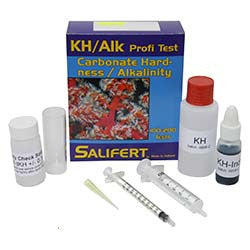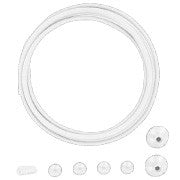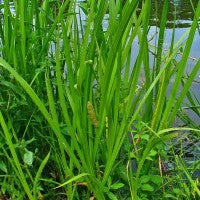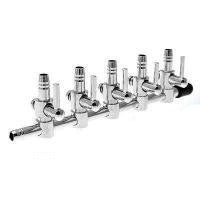Salifert kH/Alkalinity Profi Test Salifert
$ 17,80 $ 10,68
Calcium is not the only substance needed to form the skeletal material of corals and allow calcareous algae to grow. Carbonate and bicarbonate are also needed and these two substances can have a major effect on stabilizing or buffering pH levels in the aquarium in the correct range of 8.1 to 8.4.
The total carbonate and bicarbonate concentration is also called alkalinity or carbonate hardness and for a stable system the alkalinity should not fluctuate by more than 5% from the optimum level of approx. 2.8 meq/L i.e. a maximum fluctuation of 0.14 meq/L.
The Salifert test is sensitive enough to detect small changes in levels of alkalinity, measuring in steps of 0.1 meq/L and demonstrating a very sharp color change.
Sufficient for 100 to 200 tests.
The Salifert KH + pH buffer additive makes correction of the alkalinity or carbonate hardness simple and does not upset the pH of the system
Can be used for marine water, frewshwater and garden pond water.
Warning!
The KH/Alkalinity reageant contains a dye. Avoid spilling the dye on fabric and other materials since they may become stained. Keep out of reach of children. Not for consumption.
INSTRUCTIONS for usage
- Add with the 5ml syringe 4ml of water in the test vial. For a lower resolution and more tests per kit add 2 instead of 4ml.
- Shake the KH-Ind dropping bottle a few times and add 2 drops in the test vial (1 drop for the low resolution mode).
- Put the plastic tip firmly on the 1ml syringe. And draw into the syringe the KH reagent (ensure that the end of the plastic tip is constantly submersed in the KH reagent) till the lower end of the black mark of the piston is exactly at the 1.00ml mark. There will be some air present just below the piston. This is the air which was present between the end of the piston and the plastic tip. This will not influence the test result.
- Add dropwise with the 1ml syringe the KH reagent to the water in the test tube. Swril after each drop a second or two. Continue with this until the colour changes from blue/green to a orange-red or pink colour (whichever colour is observed first).
- Hold the syringe with the tip facing upwards and read the position of the now, the upper end, of the black part of the piston. The syringe has graduations of 0.01ml. Read the KH or alkalinity value from the table or calculate as follows.
If you’ve chosen for the lower resolution multiply the calculated result by 2.
Natural seawater has a KH of 8 dKH or alkalinity of 2.9 meq/L. KH and alkalinity are increased safely with Salifert’s KH + pH Buffer.
Fast Shipping and Professional Packaging
We can offer a variety of shipping options thanks to our long-term relationship with UPS FedEx DHL. Our warehouse staff will package all goods to our exacting requirements. Prior to shipping, your goods will be thoroughly examined and securely secured. We deliver to thousands of customers every day from all over the world. This is a sign of our determination to be the largest online retailer in the world. Warehouses and distribution centers are located throughout Europe as well as in the USA.
Note: Orders that contain more than one item will be assigned a separate processing time for each item.
Prior to shipment, we examine the items ordered thoroughly before sending the items. Most orders are shipped within 48 hours. The expected delivery time is 3 to 7 days.
Returns
The stock is constantly changing and cannot be fully controlled by us due to the involvement of many different parties, such as the factory and our warehouse. The levels of stock can change at any moment. You may not receive your order once the order has been made.
The policy is 30 days. If it's been longer than 30 days since you made your purchase and we're unable to offer you a complete exchange or refund.
To be eligible for a return your item must be unused and in the same condition as you received it. You must have the item in its original packaging.
Related products
Filter Media
Plant Fertilisation
Plant Fertilisation
Bacteria
CO2 Accessories
CO2 Accessories
Filter Media
Plant Fertilisation
Air Pump Accessories
Freshwater Plant
Freshwater Plant
Substrate
Conditioner
Air Pump Accessories
Air Pump Accessories
Substrate




































